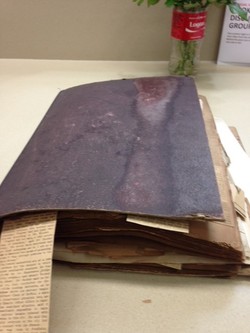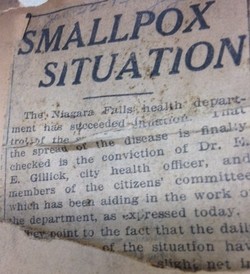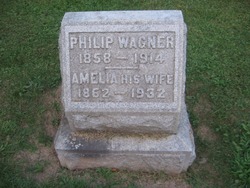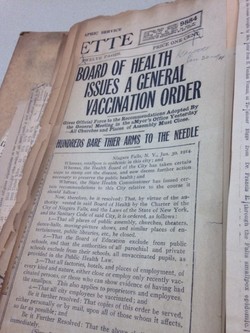By Michelle Ann Kratts
It must have seemed like the end of the world--the Apocalypse--when smallpox came to Niagara Falls, New York, in January of 1914. Luckily, the city pulled through...although it was quite a harrowing journey to the end.
It wasn't exactly a topic I wanted to dive into after a refreshing vacation at Saranac Lake, but there it was on my desk: a dusty, decrepit scrapbook filled with tattered news clippings on one subject, smallpox.
I try and imagine the person who cut these news articles from the Niagara Falls Gazette and Buffalo News. Each day the paper arrived he (I am "assuming" our smallpox enthusiast was a "he") would sit at his reading desk, scissors in hand. He would look at the glaring headlines and wonder… who would be next? What would become of the city?
Newspapers around the state issued warnings. The Buffalo health authorities suggested that "the entire city of Niagara Falls be quarantined against the world." Sixteen cases of smallpox in the town of Holland were traced to Niagara Falls, thanks to a “Holy Roller,” or religious zealot who had visited Niagara Falls and did not believe in doctors, modern medicine or vaccination. With the onset of the new year, 1914, 223 cities and towns throughout the United States were infected. For Niagara Falls was not the only city to suffer through this epidemic. There were other cities inflicted, as well—although most not as severely as our city.
In Niagara Falls, the plague began in the spring of 1913. Libraries, theaters, churches, and places of business were shut down until further notice by order of the Health Department. The New York Sun reported on February 15, 1914, that the city of Niagara Falls was experiencing such a virulent outbreak of the disease because so few of its citizens were vaccinated. In fact, Niagara Falls was said to be "an anti-vaccination center"--which, unfortunately resulted in 200 official cases of smallpox and 79 house quarantines at one time. In January of 1914, there were only three cities in the state of New York that did not require vaccination: Olean, Newburg and Niagara Falls. The situation at Niagara was so grim that the Dominion of Canada Department of Public Works "instructed its inspectors to prevent any resident of this city (Niagara Falls, NY) boarding a train for Canada unless he is able to show a certificate of recent vaccination."
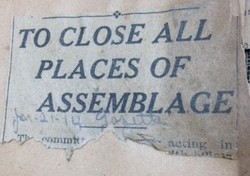
Throughout the articles I looked upon, one thing became very clear. The city of Niagara Falls had been very lax concerning vaccination. Perhaps much of the blame could be levied at the Board of Education. However, the Board of Education in the city of Niagara Falls explained that its attitude merely "reflected the sentiment of the people of the city." Dr. Linsley R. Williams, State Department of Health and Dr. Edward Clark, of Buffalo, consulted with the city health officer, Dr. Gillick, before confronting the Board of Education. Their conclusion was that the schools must comply with the State law which requires "the vaccination of all children before they are admitted to the public schools." Unfortunately, the Board "tabled any action relative to enforcing the vaccination law as related to the public schools." Even as the epidemic raged—there were those who were very fearful of vaccination and felt it was their personal right to vaccinate or not.
Throughout the month of January the city of Niagara Falls was on the brink of devastation. Each new day brought forth fresh cases. Hotels were shut down. When smallpox was found in a location all known residents were supposed to comply with quarantine rules and become vaccinated immediately. But this was not always the case. In the North End two Polish servant girls disappeared out the back door of a hotel after someone on the premises was taken to the quarantine hospital. John Scarupa, the proprietor of the location, was told he must remain closed until he could produce the “girls” for vaccination. Here is an example of the extent of the work of the Health Department:
Fifteen persons were found in the hotel and were immediately vaccinated by Dr. McDowell. A laborer dropped in for a drink just before the arrival of the health authorities. He was standing at the bar when Dr. McDowell entered the place and ordered everyone to bare his left arm. The laborer protested, but he was made to submit to the vaccination with the others in the place.
Niagara Falls Gazette
January 28, 1914
According to Dr. Clark, the dim truth was that there were most likely hundreds of smallpox cases in Niagara Falls that were NOT reported.
"I went to the Dotter home at 346 Sixth Street this morning to inquire into the case of Alice Dotter, one of four children. Alice was sent home from the Third Street School by a nurse today when smallpox developed in her. I found that the other five members of the family had had the disease and recovered without even calling a physician. This same state of affairs has likely existed in many more homes...Everyone in this city needs to be vaccinated."
A terrible situation arose when a small boy, the son of Mr. and Mrs. Pendergast, of 2305 Highland Avenue, was diagnosed with smallpox. The city health officials demanded that the child be placed immediately at the city quarantine hospital (in a building located at the corner of Sugar Street and Niagara). As was the case in some other households, Mr. and Mrs. Pendergast refused to allow their child to be taken away. Police Chief Lyons was called upon to assist in forcibly removing the child to the quarantine hospital...but he refused. When asked how many of his officers had been vaccinated, he answered: none that I know of.
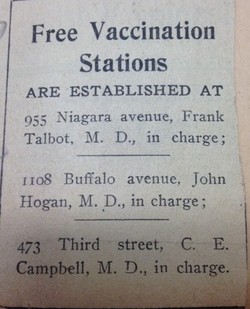
On January 26, 1914, the only reported death due to smallpox occurred at the quarantine hospital in Niagara Falls. Philip Wagner, age 55, had first taken ill on January 6th. He remained at his home on Pierce Avenue until the rash appeared on January 12th and was removed to the quarantine hospital where he remained until his death. Ultimately, the cause of death was blood poisoning, or strepticosis. Apparently smallpox causes holes to open in your skin and scab over. However the holes that form in the mouth and throat do not scab over. Mr. Wagner developed large holes in the inside of his mouth and throat "and through them the poisoning was undoubtedly received into his system which caused his death." Poor Mr. Wagner was not even allowed the luxury of a proper funeral. Due to his diagnosis of smallpox, his body was immediately removed from the hospital and hermetically sealed in a steel coffin which was transported to Oakwood Cemetery and deposited into the vault. Following this unfortunate death Dr. Gillick and Dr. Clark declared two new rules of quarantine. One made it mandatory for every person contracting the disease to be taken to the quarantine hospitals instead of being quarantined in their homes. The other new regulation provided that no one be released from a quarantine house until three weeks after the last case of smallpox therein has been pronounced cured and the place fumigated.
Many unscrupulous and dangerous happenings occurred during the outbreak. The quarantine rules were often broken. Complaints were made against a business man, a resident of Chilton Avenue, whose son was ill with smallpox. It was said that "he had gone in and out of the house unmolested, though a quarantine guard stood in front of the place."
The only way to eliminate smallpox and to end this plague upon the city of Niagara Falls was to vaccinate every single person. During an emergency meeting, Rev. David Weeks, pastor of the Church of the Epiphany, stated that vaccination should have been insisted upon last October when there were only sixteen cases of smallpox in the quarantine hospital. The Niagara Falls Business Men's Association adopted special resolutions in support of the local and state authorities in their efforts to stamp out the epidemic. Fred Mason of the Shredded Wheat Company announced that they would employ only vaccinated persons. Things began to brighten as the Board of Education resolved that as of February 2, 1914, "the schools of our city will be directed to refuse admission to all un-vaccinated persons unless they have had smallpox."
Finally by the middle of March, after the vaccination of thousands of Niagarans, the smallpox epidemic was over...and the plague, otherwise known as smallpox, never returned to this city.
Hopefully, our friend, the newspaper clipper was finally able to set his mind at ease when the Niagara Gazette reported:
QUARANTINE IS LIFTED; NORMAL CONDITIONS SOON TO PREVAIL
